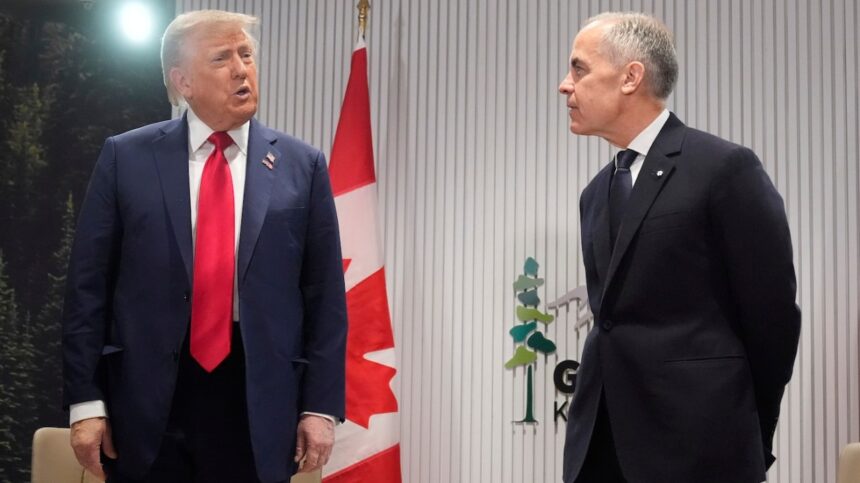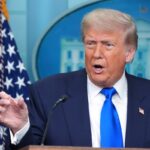Article – President Trump abruptly terminated bilateral trade negotiations with Canada yesterday, signaling what could become a significant new front in his administration’s aggressive trade agenda. The decision came after two days of reportedly tense discussions in Washington between U.S. Trade Representative Samuel Carson and Canadian Minister of International Trade Mary Ellison.
“Canada needs to understand America won’t be taken advantage of anymore,” Trump declared during an impromptu press conference at his Mar-a-Lago estate. “If they don’t come back to the table with serious concessions, we’re looking at tariffs – big tariffs – as high as 25% across multiple sectors.”
The breakdown in talks has caught many policy experts off guard, particularly given the recent ratification of the USMCA agreement that replaced NAFTA. Sources close to the negotiations indicate disputes centered primarily around dairy access, softwood lumber, and new digital services provisions that the U.S. team introduced mid-discussion.
I spoke with three Canadian officials who requested anonymity due to the sensitive nature of the negotiations. “We came prepared to discuss modest adjustments to the existing framework,” one senior trade ministry official explained. “Instead, we faced an entirely new set of demands that would require us to essentially rewrite significant portions of the USMCA barely two years after implementation.”
The timing puzzles many observers. Economic integration between the U.S. and Canada remains among the world’s most comprehensive, with approximately $2.6 billion in goods and services crossing the border daily, according to U.S. State Department figures. Canada currently purchases more American goods than any other nation, supporting an estimated 9 million U.S. jobs.
“This is political theater masquerading as trade policy,” said Rebecca Greenwald, senior fellow at the Peterson Institute for International Economics. “The administration is creating artificial crises with allies to demonstrate toughness ahead of midterms, but these actions have real economic consequences.”
On Capitol Hill, reactions have fallen along partisan lines. Senator James Morrison (R-Ohio) praised the president’s approach, arguing that “Canada has exploited loopholes in our trade relationship for decades.” Meanwhile, Representative Elena Vasquez (D-Michigan) called the move “reckless economic brinkmanship” that threatens automotive supply chains critical to her state.
Last evening, I traveled to Port Huron, Michigan, where I met with trucking company owner Dave Larson, whose fleet makes over 200 border crossings weekly. “We’re already dealing with driver shortages and fuel costs,” Larson told me as we watched an endless stream of semi-trucks approaching the Blue Water Bridge. “Another trade fight means more paperwork, longer delays, higher prices. Nobody wins.”
The Canadian dollar fell 1.2% against the U.S. dollar following Trump’s announcement, while the Toronto Stock Exchange dropped nearly 300 points. Market analysts predict continued volatility as investors assess the likelihood of escalation.
Prime Minister Justin Trudeau responded with uncharacteristic sharpness during a press conference in Ottawa. “Canada has been and remains America’s most reliable trading partner,” Trudeau stated. “We won’t negotiate through threats or public posturing. When the U.S. administration is prepared to engage constructively, we’ll be here.”
This latest move fits a pattern of the president’s approach to international negotiations—creating crisis points to leverage concessions. However, the strategy carries significant risks, according to Dr. Miranda Chen, Director of North American Studies at Georgetown University.
“Trade relationships aren’t light switches you can flip on and off,” Chen explained during our conversation yesterday. “They’re complex ecosystems built on trust, regulatory alignment, and business expectations. Disrupting them for short-term political gain creates long-term institutional damage that outlasts any administration.”
For communities along the 5,525-mile U.S.-Canada border, the potential impact extends beyond economics. In Plattsburgh, New York, Mayor Thomas Reynolds expressed concern about the cultural consequences. “Our Canadian neighbors aren’t just trading partners, they’re friends and family,” Reynolds said. “We share hockey leagues, attend each other’s community events. Creating artificial divisions damages relationships built over generations.”
The White House has indicated that negotiations could resume “when Canada demonstrates seriousness” about addressing U.S. concerns, though specific benchmarks remain unclear. Meanwhile, the Commerce Department has reportedly begun preliminary work on tariff implementation plans targeting Canadian automotive parts, aluminum, and agricultural products.
As both nations prepare for what could be a prolonged standoff, the economic stakes continue to grow. According to the U.S. Chamber of Commerce, even a brief trade disruption could cost American businesses billions, with particularly severe impacts on manufacturing, agriculture, and energy sectors.
Standing at the Windsor-Detroit border crossing this morning, watching commerce flow uninterrupted despite the diplomatic turbulence, one can’t help but wonder how long this essential economic relationship can withstand being used as a political bargaining chip. For now, businesses and communities on both sides of the world’s longest international border find themselves, once again, caught in geopolitical crosscurrents beyond their control.






